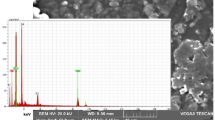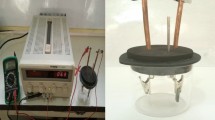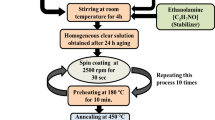Abstract
The effect of thickness modifications of zinc oxide (ZnO) thin films and the impressions over the electrical and optical characteristics were analyzed. ZnO thin films were deposited by the sol–gel spin coating method. For measuring the thickness of the films, a surface profilometer was operated. By maintaining an unvarying density of sol–gel (with 2% fabrication tolerance), the thin films were deposited on glass substrates. To identify the changes in optical variables, an ultraviolet–visible (UV–Vis) spectrophotometer was used. With the increment of deposition thickness, a nonlinear difference in skin depth has been observed. The bandgap showed a redshift and was in the range of 3.27–3.25 eV which is suitable for photonic applications. Electrical parameters were defined by ECOPIA Hall effect measurement system. The maximum measured sheet resistance in the current research is 5.43 × 107 (Ω/square) for 200 nm thin film. For 100 nm thickness, high mobility (221 cm2 V−1 s−1) and small resistivity (306.3) (Ω-cm) has been obtained. The above-mentioned high mobility and small resistivity are highly desirable for the transparent electrode of CIS solar cells and buffer layer.



Similar content being viewed by others
References
M. Jacobs, S. Muthukumar, A. PanneerSelvam, J. Engel Craven, S. Prasad, Ultra-sensitive electrical immunoassay biosensors using nanotextured zinc oxide thin films on printed circuit board platforms. Biosens. Bioelectron. 55, 7–13 (2014). https://doi.org/10.1016/j.bios.2013.11.022
P. Luo, M. Xie, J. Luo, H. Kan, Q. Wei, Nitric oxide sensors using nanospiral ZnO thin film deposited by GLAD for application to exhaled human breath. RSC Adv. 10(25), 14877–14884 (2020). https://doi.org/10.1039/d0ra00488j
M. Shkir et al., Investigation on structural, linear, nonlinear and optical limiting properties of sol–gel derived nanocrystalline Mg doped ZnO thin films for optoelectronic applications. J. Mol. Struct. 1173, 375–384 (2018). https://doi.org/10.1016/j.molstruc.2018.06.105
C.H. Chung, T. Park, S. Lee, Thermal stability data of silver nanowire transparent conducting electrode. Data Brief. 12(30), 105422 (2020). https://doi.org/10.1016/j.dib.2020.105422
M.B. Tahir, H. Javad, K. Nadeem, A. Majid, ZnO thin films: recent development, future perspectives and applications for dye sensitized solar cell. Surf. Rev. Lett. 25, 7 (2018). https://doi.org/10.1142/S0218625X19300016
L.N.M.Z. Saputri, A.H. Ramelan, Q.A. Hanif, Y.I.F. Hasanah, L.B. Prajanira, S. Wahyuningsih, Optimalization activity of ZnO NR/TiO2 NR-P3HT as an active layer based on hybrid bulk heterojunction on dye sensitized solar cell (DSSC). AIP Conf. Proc. 1725, 3–10 (2016). https://doi.org/10.1063/1.4945530
R. Agarwal, K.R. Ko, P.F. Gratzer et al., Biopatterning of keratinocytes in aqueous two-phase systems as a potential tool for skin tissue engineering. MRS Adv. 2, 2443–2449 (2017). https://doi.org/10.1557/adv.2017.357
H.H. Singh, N. Khare, Flexible ZnO-PVDF/PTFE based piezo-tribo hybrid nanogenerator. Nano Energy 51, 216–222 (2018). https://doi.org/10.1016/j.nanoen.2018.06.055
L. Kang et al., La-doped p-type ZnO nanowire with enhanced piezoelectric performance for flexible nanogenerators. Appl. Surf. Sci. (2019). https://doi.org/10.1016/j.apsusc.2019.01.025
R. Bairy, P.S. Patil, S.R. Maidur, H. Vijeth, M.S. Murari, U.K. Bhat, The role of cobalt doping in tuning the band gap, surface morphology and third-order optical nonlinearities of ZnO nanostructures for NLO device applications. RSC Adv. 9(39), 22302–22312 (2019). https://doi.org/10.1039/c9ra03006a
B. Abdallah et al., Oxygen effect on structural and optical properties of ZnO thin films deposited by RF magnetron sputtering. Mater. Res. Ibero Am. J. Mater. 20, 607–612 (2017). https://doi.org/10.1590/1980-5373-MR-2016-0478
P. Raizada, A. Sudhaik, P. Singh, Photocatalytic water decontamination using graphene and ZnO coupled photocatalysts: a review. Mater. Sci. Energy Technol. 2(3), 509–525 (2019). https://doi.org/10.1016/j.mset.2019.04.007
D.B. Potter, M.J. Powell, I.P. Parkin, C.J. Carmalt, Aluminium/gallium, indium/gallium, and aluminium/indium co-doped ZnO thin films deposited: via aerosol assisted CVD. J. Mater. Chem. C 6(3), 588–597 (2018). https://doi.org/10.1039/c7tc04003b
H. Alvi, Luminescence Properties of ZnO Nanostructures and Their Implementation as White Light Emitting Diodes (LEDs) Naveed ul Hassan Alvi, no. 1378 (2011)
W.J. Jeong, S.K. Kim, G.C. Park, Preparation and characteristic of ZnO thin film with high and low resistivity for an application of solar cell. Thin Solid Films 506–507, 180–183 (2006). https://doi.org/10.1016/j.tsf.2005.08.213
Clean Energy Institute - University of Washington, “Copper Indium Selenide (CIS) Solar Cell” (2014). Available: https://www.cei.washington.edu/wordpress/wpcontent/uploads/2014/04/PVcelldisplaycards.pdf.
S.K. Mishra, B.D. Gupta, Surface plasmon resonance-based fiber-optic hydrogen gas sensor utilizing indium-tin oxide (ITO) thin films. Plasmonics 7(4), 627–632 (2012). https://doi.org/10.1007/s11468-012-9351-7
M.F. Al-Kuhaili, Electrical conductivity enhancement of indium tin oxide (ITO) thin films reactively sputtered in a hydrogen plasma. J. Mater. Sci. Mater. Electron. 31(4), 2729–2740 (2020). https://doi.org/10.1007/s10854-019-02813-9
J. Lian et al., Amorphous silicon on indium tin oxide: a transparent electrode for simultaneous light activated electrochemistry and optical microscopy. Chem. Commun. 55(1), 123–126 (2019). https://doi.org/10.1039/c8cc07889k
Xu. Li et al., Study on structural and optical properties of Mn-doped ZnO thin films by sol–gel method. Opt. Mater. (2020). https://doi.org/10.1016/j.optmat.2020.109657
M.R. Rahman, M.N. Uddin, T. Ashrafy et al., Tuning of Optical band gap: genesis of thickness regulated Al doped ZnO nano-crystalline thin films formulated by sol–gel spin coating approach. Trans. Electr. Electron. Mater. 23, 205–218 (2022)
G. Wisz, I.S. Virt, P. Sagan, P. Potera, R. Yavorskyi, Structural, optical and electrical properties of zinc oxide layers produced by pulsed laser deposition method. Nanoscale Res. Lett. (2017). https://doi.org/10.1186/s11671-017-2033-9
J.I. Scott, R.F. Martinez-Gazoni, M.W. Allen, R.J. Reeves, Optical and electronic properties of high-quality Sb-doped SnO2 thin films grown by mist chemical vapor deposition. J. Appl. Phys. (2019). https://doi.org/10.1063/15116719
M.N.H. Mia, M.F. Pervez, M. Khalid Hossain, M. Reefaz Rahman, M. Jalal Uddin, M.A. Al Mashud, H.K. Ghosh, M. Hoq, Influence of Mg content on tailoring optical bandgap of Mg-doped ZnO thin film prepared by sol-gel method. Results Phys. 7, 2683–2691 (2017). https://doi.org/10.1016/j.rinp.2017.07.047
N.H. Mia, S.M. Rana, F. Pervez, M.R. Rahman, K. Hossain, A.A. Mortuza, M.K. Basher, M. Hoq, Preparation and spectroscopic analysis of zinc oxide nanorod thin films of different thicknesses. Mater. Sci. Pol. 35(3), 501–510 (2017). https://doi.org/10.1515/msp-2017-0066
G. Hautier, A. Miglio, G. Ceder, G.M. Rignanese, X. Gonze, Identification and design principles of low hole effective mass p-type transparent conducting oxides. Nat. Commun. 4, 1–7 (2013). https://doi.org/10.1038/ncomms3292
M.R. Rahman, et al., A comprehensive optical and electrical properties analysis of Mg doped ZnO nanocrystalline thin-films for optoelectronic applications, in 2020 IEEE International Conference on Advent Trends in Multidisciplinary Research and Innovation (ICATMRI) 1–6 (2020). https://doi.org/10.1009/icatmri51801.2020-9398515
M.R. Rahman, T. Ashrafy, M.N. Uddin, M. Hoq, F. Alam, A.H. Jalal, Comprehensive Analysis of Conductive and Optically Transparent Sol-Gel Spin Coated Al3+ and Sn4+ Doped Zno Nano Crystalline Thin-Films. Available at SSRN 4412868
N. Bahadur, A.K. Srivastava, S. Kumar, M. Deepa, B. Nag, Influence of cobalt doping on the crystalline structure, optical and mechanical properties of ZnO thin films. Thin Solid Films 518(18), 5257–5264 (2010). https://doi.org/10.1016/j.tsf.2010.04.113
R.K. Gupta, Z. Serbeti, F. Yakuphanoglu, Bandgap variation in size controlled nanostructured Li–Ni co-doped CdO thin films. J. Alloys Compd. 515, 96–100 (2012). https://doi.org/10.1016/j.jallcom.2011.11.098
E. Tüzemen, S. Eker, H. Kavak, R. Esen, Dependence of film thickness on the structural and optical properties of ZnO thin films. Appl. Surf. Sci. 255, 6195–6200 (2009). https://doi.org/10.1016/j.apsusc.2009.01.078
J. Lee, D.C. Sorescu, X. Deng, J. Phys. Chem. Lett. 7(7), 1335–1340 (2016). https://doi.org/10.1021/acs.jpclett.6b00432
Y. Pan, Topological Origin of the Urbach Tail, no. March, p. 102, (2009). http://etd.ohiolink.edu/view.cgi?acc_num=ohiou1235514573. Available: http://etd.ohiolink.edu/send-pdf.cgi/Pan
A.S. Gadallah, M.M. El-Nahass, Structural, optical constants and photoluminescence of ZnO thin films grown by sol-gel spin coating. Adv. Condens. Matter Phys. (2013). https://doi.org/10.1155/2013/234546
A. Maqsood, M. Islam, M. Ikram, S. Salam, S. Ameer, Synthesis, characterization and hall effect measurements of nano-crystalline ZnO thin films. Key Eng. Mater. 510–511(1), 186–193 (2012). https://doi.org/10.4028/www.scientific.net/KEM.510-511.186
S. Kishimoto, T. Yamamoto, Y. Nakagawa, K. Ikeda, H. Makino, T. Yamada, Dependence of electrical and structural properties on film thickness of undoped ZnO thin films prepared by plasma-assisted electron beam deposition. Superlattices Microstruct. 39(1–4), 306–313 (2006). https://doi.org/10.1016/j.spmi.2005.08.069
M. Bouderbala et al., Thickness dependence of structural, electrical and optical behaviour of undoped ZnO thin films. Phys. B Condens. Matter 403(18), 3326–3330 (2008). https://doi.org/10.1016/j.physb.2008.04.045
J.M. Myoung, W.H. Yoon, D.H. Lee, I. Yun, S.H. Bae, S.Y. Lee, Effects of thickness variation on properties of ZnO thin films grown by pulsed laser deposition. Jpn. J. Appl. Phys. Part Regul. Pap. Short Notes Rev. Pap. 41(1), 28–31 (2002). https://doi.org/10.1143/JJAP.41.28
Acknowledgements
The authors want to concede the generous assistance from the Department of Glass and Ceramic Engineering (GCE) of Bangladesh University of Engineering and Technology (BUET), for SEM images and the Institute of Fuel Research & Development (IFRD) of Bangladesh Council of Scientific and Industrial Research (BCSIR), Bangladesh for XRD graphs.
Author information
Authors and Affiliations
Corresponding author
Ethics declarations
Conflict of interest
The authors declare that they have no known competing financial interests or personal relationships that could have appeared to influence the work reported in this paper.
Additional information
Publisher's Note
Springer Nature remains neutral with regard to jurisdictional claims in published maps and institutional affiliations.
Rights and permissions
Springer Nature or its licensor (e.g. a society or other partner) holds exclusive rights to this article under a publishing agreement with the author(s) or other rightsholder(s); author self-archiving of the accepted manuscript version of this article is solely governed by the terms of such publishing agreement and applicable law.
About this article
Cite this article
Rahman, M.R., Uddin, M.N., Ashrafy, T. et al. Thickness-Regulated Harmonious Effect on the Optical and Electrical Characteristics of ZnO Nano-Crystalline Thin Films for High Mobility Transparent Electrode. Trans. Electr. Electron. Mater. 24, 323–329 (2023). https://doi.org/10.1007/s42341-023-00450-y
Received:
Revised:
Accepted:
Published:
Issue Date:
DOI: https://doi.org/10.1007/s42341-023-00450-y




